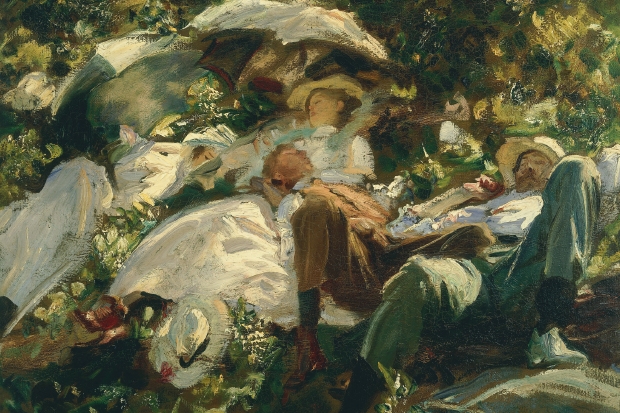The artist Malcolm Morley once fantasised about a magazine that would be devoted to the practice of painting just as some publications are to — say — cricket. It would be filled with articles extolling feats of the brush, rather than the bat. ‘Well painted, sir!’ the contributors would exclaim at an especially brilliant display of visual agility. ‘Fine stroke!’ If such a periodical had existed in the late Victorian and Edwardian ages, no one would have been heaped with more praise than John Singer Sargent (1856–1925).
Sargent: Portraits of Artists and Friends at the National Portrait Gallery is filled with mesmerising displays of his skills. There are so many, indeed, that to list them would be to describe just about every picture on view. There is, to choose an example almost at random, the ostentatious casualness with which a few slashes and dabs of whitish pigment over greenish-grey perfectly evoke the silk dress of ‘Mrs George Batten Singing’ (1897). In the same way, the pinkish-blue lolling tongue of Asher Wertheimer’s poodle, in the extreme bottom left, brings what is otherwise a more or less monochrome portrait to witty, outrageous life.
Or consider the pitch-perfect transition between shade and Mediterranean sun in ‘Ramón Subercaseaux in a Gondola’ (c.1880), which depicts a friend of the painter sketching under a canopy while rippling canal water can be seen beyond. Sargent revelled in such tricky contrasts — his celebrated ‘Carnation, Lilly, Lily, Rose’ (c. 1885–6) turns on the distinction between the evening gloaming and the bright Chinese lanterns being lit by — to my mind — a couple of sickly sweet children.
His portrait ‘Madame X’ (not exhibited at the NPG) caused a scandal when it was shown at the Paris Salon of 1884, because of its unabashed sensuality. It looked like what it probably was, a picture of a beautiful socialite who was far from faithful to her husband. Sargent withdrew to London and reined in his tendencies to salacious raciness.
They were still there, though, in the best of his works. Indeed, ‘Mrs George Batten Singing’ goes rather further in suggestiveness than ‘Madame X’. The sitter, whose lovers included the Prince of Wales, Wilfrid Scawen Blunt and Radclyffe Hall, author of the pioneering lesbian novel The Well of Loneliness, is portrayed with closed eyes and open mouth in an ecstasy that does not seem entirely musical.
The two portraits of Robert Louis Stevenson (1885 and 1887) show Sargent’s knack for a type of portraiture that came close to caricature. They present the writer, as he put himself, as a ‘weird, very pretty, large-eyed, chicken-boned, slightly contorted poet’. Sargent let himself go like this in the more private pictures, and in those of more bohemian sitters. Those provide the highlights of the show.
Anyone who enjoys the art of painting is bound to find endless charm, skill and virtuosity in Sargent’s work. This exhibition, which focuses on pictures of friends, writers, musicians, actors and fellow artists, emphasises the best in him. The fun and verve are not kept on a leash, as they tended to be in his portraits of the grand and the plutocratic. In many ways this is a worthy way to conclude Sandy Nairne’s directorship at the NPG, during which the gallery has mounted numerous outstanding shows.
So why not leave it at that? I cannot subdue the feeling that there is something unsatisfactory about Sargent. Perhaps he was a case of talent that flowed too easily. You never get much sense of him struggling to do something immensely hard — and occasionally failing — as you do with Manet, Degas or Cézanne. Or maybe he lacked the nerve fully to follow his gifts.
Whatever the cause, there is a lingering sense of disappointment about Sargent’s career. The exhibition dwindles away into an Edwardian travelogue in which his friends are seen sketching in pleasant spots abroad. The brilliance was still there, but with too much gloss and not enough truth. He was so good he should have been better.
Sargent was nominally American but really a perfect example of the transatlantic cosmopolite described by his friend, supporter and sitter Henry James, equally at home in Boston, Paris and London. His fellow countryman Jacob Epstein (1880–1959) was, you might say, an outsider everywhere. Born to a Polish–Jewish family in the Lower East Side of New York, he studied sculpture in Paris and settled in London.
Although eventually he attained grand old man status — and a knighthood — his career was long dogged by the scandal and vicious criticism that Sargent experienced over ‘Madame X’. A small, engaging exhibition at the Foundling Museum, Sir Jacob Epstein: Babies and Bloomsbury, focuses largely on one favourite subject, infants and children. Many of his sitters were his own children, of which there were five (all illegitimate), although the best of the sculptures is of ‘Romilly John’ (1907), son of Augustus, whose head is encased in a sort of helmet: the baby as martial modernist.
Epstein’s wife Margaret, who was unable to have children, tolerated most of his lovers but shot the one who meant most to him, Kathleen Garman (fortunately not fatally). Kitty, Epstein’s daughter by Garman, was later briefly married to Lucian Freud. Their daughters, Ann and Annabel Freud, also feature in this array of angst-ridden bronze putti.
As the catalogue notes, Epstein’s private life was complicated, tumultuous and unorthodox. The same could be said for that of Lucian Freud, who nonetheless found his father-in-law’s ménage intriguingly mysterious. He once told me about going to Epstein’s rambling house to sit for a portrait. ‘His studio was on the ground floor and bedroom on the first. On the way out I asked him what went on on the second floor. He replied, “How should I know? I haven’t the faintest idea.” It was very odd.’






Comments